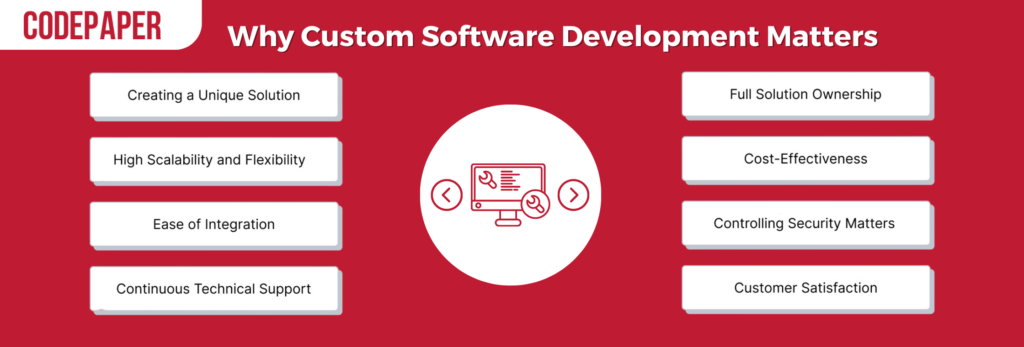In today’s fast-paced and ever-changing business landscape, companies are increasingly turning to custom software development to solve complex problems and gain a competitive edge. But what exactly,
“?:and why does it matter? In this guide, we’ll explore the key stages of custom software development and provide insights into best practices, tools, technologies, and real-world case studies.
Introduction to Custom Software Development and Why It Matters

Custom software development involves designing, building, testing, deploying, and maintaining software that is specifically tailored to meet the unique needs of a particular organization. Unlike off-the-shelf software, custom software is created from scratch to address specific business problems or opportunities.
Custom software development matters because it allows companies to create solutions that are unique to their business, giving them a competitive advantage in their industry. With custom software, businesses can streamline processes, automate tasks, improve customer experiences, and drive revenue growth.
Ideation: How to Identify Business Problems and Develop Solutions with Custom Software
The ideation stage of custom software development involves identifying business problems or opportunities and developing solutions to address them. This stage typically involves a collaborative process between business stakeholders, software developers, and designers.
To identify business problems, companies can use a variety of tools, such as user surveys, focus groups, and data analysis. Once problems have been identified, software developers and designers can work together to develop solutions that meet the specific needs of the organization.
Designing Your Custom Software: Best Practices and Tools
The design stage of custom software development involves creating a blueprint for the software solution. This stage typically involves user experience (UX) designers, user interface (UI) designers, and software architects.
Best practices for designing custom software include creating user personas, developing wireframes and mockups, and conducting usability testing. Tools commonly used in the design stage include Sketch, Figma, and Adobe XD.
Developing Custom Software: Agile Methodologies and Building for Scalability
The development stage of custom software involves building the software solution using coding and programming languages. This stage typically involves software engineers, developers, and project managers.
Agile methodologies are commonly used in custom software development to facilitate collaboration, flexibility, and speed. Building for scalability is also a critical consideration during the development stage, as it ensures that the software solution can handle increased usage and growth over time.

Testing Your Custom Software: Ensuring Functionality, Usability, Performance, and Security
The testing stage of custom software development involves ensuring that the software solution is functional, usable, performs well, and is secure. This stage typically involves quality assurance (QA) engineers, testers, and security experts.
Testing best practices include creating test plans, conducting automated and manual testing, and performing security testing to identify vulnerabilities. Testing ensures that the software solution meets the specific needs of the organization and its users.
Deployment and Maintenance: Launching Your Custom Software and Keeping It Running Smoothly
The deployment and maintenance stage of custom software development involves launching the software solution and ensuring that it runs smoothly over time. This stage typically involves DevOps engineers, system administrators, and support staff.
Deployment best practices include using deployment automation tools, creating backups and disaster recovery plans, and monitoring software performance and uptime. Maintenance involves regular updates, bug fixes, and security patches to ensure that the software solution remains effective and secure.
Case Studies: Real-World Examples of Custom Software Development Success Stories
Real-world case studies provide valuable insights into the benefits of custom software development. Examples of successful custom software solutions include the Salesforce CRM, which has revolutionized sales and customer relationship management, and the Uber app, which has disrupted the transportation industry.
Choosing the Right Custom Software Development Partner: What to Look For and Why It Matters
Choosing the right custom software development partner is crucial to the success of your project. Here are some key factors to consider:

Experience: Look for a partner with a proven track record of delivering high-quality custom software solutions.
Expertise: Make sure the partner has experience in the technologies and tools required for your project.
Communication: Choose a partner who communicates clearly and regularly throughout the development process.
Collaboration: Look for a partner who values collaboration and works closely with your team to understand your business needs and goals.
Cost: Consider the partner’s pricing structure and ensure it aligns with your budget.
Looking for a top software development company in Canada? Codepaper provide to startup and enterprise-level businesses.
The Future of Custom Software Development: Emerging Technologies and Trends to Watch
As technology continues to evolve, so too will the world of custom software development. Here are some emerging technologies and trends to keep an eye on:
AI and Machine Learning: These technologies are becoming increasingly important in custom software development, enabling software to learn and adapt to user behavior.
Blockchain: This technology is transforming industries from finance to healthcare and has the potential to revolutionize how custom software is developed and deployed.
Low-Code/No-Code Development: These tools are making it easier for non-technical users to develop custom software solutions without the need for extensive coding knowledge.
Serverless Computing: This approach to computing eliminates the need for server management and maintenance, allowing for faster and more efficient software development.
Conclusion: Putting It All Together and Taking the Next Steps in Your Custom Software Development Journey.
Custom software development is a complex process that requires careful planning, execution, and management. By following the best practices outlined in this guide and choosing the right development partner.
Remember to focus on ideation, design, development, testing, deployment, and maintenance, and keep an eye. With the right approach and partner, you can create a software solution that drives business growth and success. To learn more, visit our website.